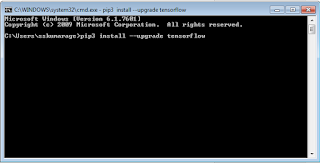Popular posts from this blog
Installing Keras Before installing keras you need to install one of its back end engines. Here we use Tensor Flow as the back end engine. There are other back end engines as well. This is the recommended one. Installing Tensor Flow On Windows Installing with native pip One of the following versions of python should be installed in your machine. Python 3.5.x 64-bit from python.org Python 3.6.x 64-bit from python.org Download this installer for windows (64 bit) machines Windows x86-64 executable installer
Compilation of the module Compilation configure the learning process of the module. It is done via compile method. It takes 3 arguments. Optimizer Can use string identifier of an existing optimizer (rmsprop | adagrad) or instance of an existing Optimizer. Loss Function Model always tries to minimize the loss. Can use existing string identifier of an loss function ( mse | categorical_crossentropy)or an objective function. A list of metrics For any classification problem set metrics to accuracy. metrics=['accuracy'] metric could be a string identifier , existing metric or custom metric function. # For a binary classification problem model.compile(optimizer='rmsprop', loss='binary_crossentropy', metrics=['accuracy']) # For a mean squared error regression problem model.compile(optimizer='rmsp...





Comments
Post a Comment